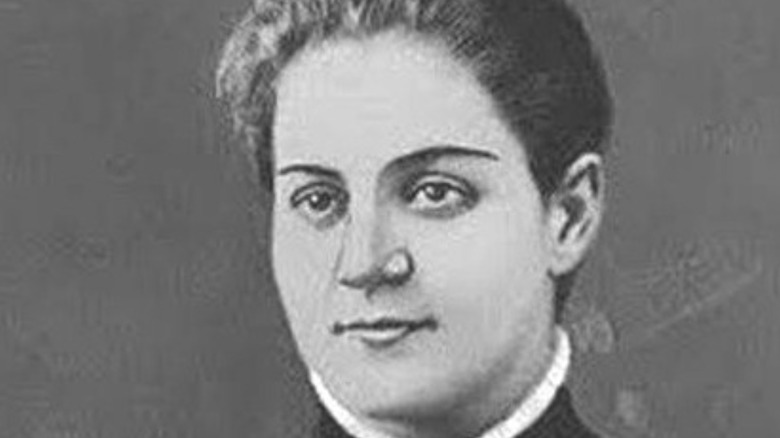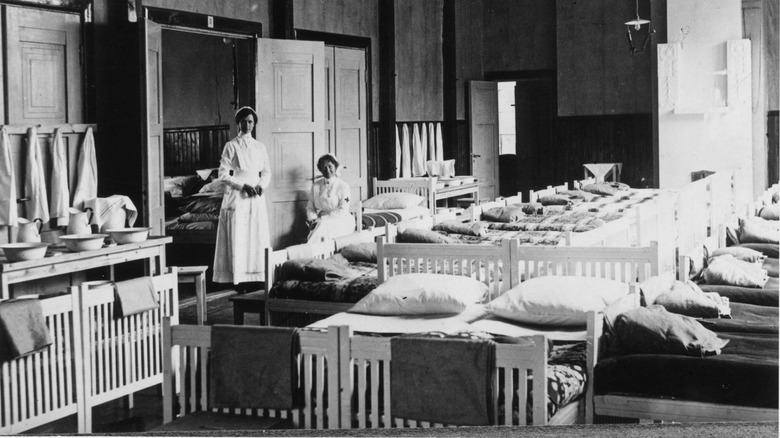The Tragic Truth About Serial Killer Jane Toppan's Childhood
Killers have always walked among us. From the alleyways of Whitechapel where Jack the Ripper lurked to the highways of the United States where Henry Lee Lucas plucked his victims, serial killers can be anywhere. But when one thinks of becoming another notch in the belt of a prolific killer, nurses are seldom thought of as the perpetrators. It's unsettling to think that Jane Toppan used this vocation as a means to get her psychotic thrills, by way of poisoning her patients.
When the killer nurse was finally convicted of murder in 1902, her official death count was 12 victims (via The Clinton Morning Age). Toppan had confessed to her attorney that she had murdered many more, with an actual death count possibly being 100 or more (via New England Historical Society). While some of her victims were friends and relatives, a good number of them were patients that were left in Toppan's care in a hospital or as a private nurse. Toppan was found not guilty by reason of insanity and sent to an asylum where she died at age 81 in 1938.
Toppan's motives for murder existed in several layers; she was known to have a belief that elderly people were useless and a burden, but that wasn't the whole story. Toppan also admitted that she was sexually aroused by seeing people die, making her crimes that much more disturbing. But how did Jane Toppan become so sadistic?
Insanity runs in the family
Born as Honora Kelley in Boston in 1857, Toppan's story begins in tragedy. Her mother died from tuberculosis when Toppan was just a year old. The poor Irish immigrant household she was born into was a harsh one. Now being raised by a widower, the girl who would grow up to be "Jolly" Jane Toppan was subjected to her father's neglect and abuse (via New England Historical Society). The Kelley patriarch was a known alcoholic who suffered from mental illness. He created a horrific environment for his three daughters.
A tailor by trade, it was said that Kelley went mad at work and sewed his own eyes shut. Not able to provide for his youngest children, he arranged for them to be taken to the Boston Female Asylum to live. Honora was 6 years old when she was forced to live in the orphanage, her sister Delia was 8. The eldest daughter, Nellie, was not brought to the same home as her younger siblings. She died in an insane asylum several years later.
At the age of 10, Honora was sent to live as an indentured servant with a well-to-do Boston family named Toppan. Fearing the stigma associated with the Irish at the time, her new family gave her their surname and changed her first name to Jane. In a better environment, it could be said that the young Kelley girls would have a better chance at acclimating to polite society. Unfortunately, that's not how things turned out for them.
The road to becoming a nurse
Toppan's sister, Delia, later left her new home. To make ends meet she began working as a prostitute. Like her father before her, Delia also developed an addiction to alcohol (via New England Historical Society). Her personality traits were much different than her younger sister, Jane, however.
Toppan was said to have had the attributes of a sociopath as an adolescent. While she was moderately popular among her peers, Toppan had the reputation of being a compulsive liar. She falsely claimed that her father was a sea captain who was sailing around the world. She also said she had a brother who was decorated for his service at the Battle of Gettysburg by President Abraham Lincoln.
Even though she was well taken care of, Toppan wasn't considered a daughter by the Toppan family. She was, after all, indentured to them in exchange for room, board, and an education. At the age of 18, Toppan's servitude was over. She was given $50 and sent away to find her own path. After working for several years as a housekeeper, she began training as a nurse at Cambridge Hospital in Boston (via Crime Museum). Had she remained a housekeeper, who knows how many lives would have been spared from Jolly Jane Toppan.


